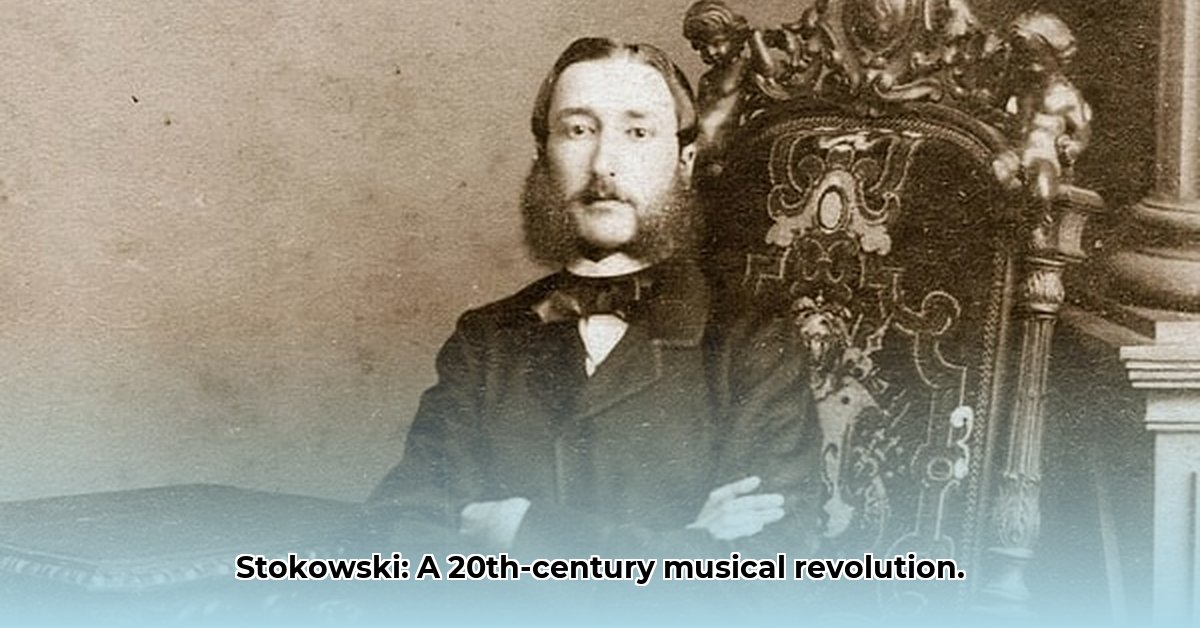Explore the life of Leopold Stokowski, a conductor who reshaped orchestral music. His groundbreaking techniques, innovative seating arrangements, and pioneering film scores left an enduring impact on the world of classical music. Delve into his genius, controversies, and lasting legacy. For a more detailed biography, check out this resource.
Leopold Stokowski: A Biography of Innovation
Leopold Stokowski’s biography reveals a story of musical innovation, marked by both controversy and undeniable achievements. His influence continues to resonate, transforming our experience of orchestral music and audio fidelity.
The Early Years: Forging a Musical Path
Stokowski’s education at the Royal College of Music in London was pivotal in shaping his unique style. His mastery of the organ cultivated a profound understanding of sonic textures. This foundation honed his ear and sculpted his artistic vision, leading to his revolutionary and sometimes controversial approach to orchestral music. How did his early expertise on the organ influence his later innovations with orchestras?
The Philadelphia Orchestra: Crafting the “Stokowski Sound”
His tenure with the Philadelphia Orchestra cemented his legacy. Stokowski’s decision to conduct without a baton, coupled with his encouragement of “free bowing” and “free breathing,” resulted in the creation of the renowned “Stokowski Sound”—a lush, rich, and textured sonic landscape. He further revolutionized orchestral seating arrangements to achieve specific tonal effects, pushing boundaries and sparking debate among critics and historians.
Pushing Technological Boundaries: Redefining Audio Recording
Stokowski embraced technological advancements, pioneering the use of microphones in recordings. His meticulous experimentation significantly impacted audio fidelity and shaped modern recording practices, further solidifying his lasting legacy as a visionary in sound.
Hollywood and Beyond: Democratizing Classical Music
Stokowski’s collaboration with Walt Disney on Fantasia bridged the gap between classical music and a broader audience. The film’s stunning visuals complemented his orchestral arrangements, making classical music accessible and universally appealing. His understanding of collaborative artistry broadened appreciation for the genre and cemented his cultural significance.
Championing Innovation: Elevating Composers
Stokowski dedicated himself to championing contemporary composers, commissioning and performing their groundbreaking works. This unwavering support altered the trajectory of classical music, providing a platform for avant-garde artists and bringing recognition to often-overlooked compositions. He aimed to give visibility to experimental pieces that many considered too risky for mainstream audiences.
Controversies and Enduring Influence: A Complex Legacy
Stokowski’s reinterpretations of original scores sparked debate among music historians, raising essential questions about artistic interpretation versus alteration. While his legacy remains complex, his impact is undeniably significant. He redefined orchestral music, advanced the field of recording, and broadened its appeal to global audiences, challenging and inspiring us with music’s dynamic evolution.
Stokowski’s Lasting Impact: A Summary
| Aspect | Positive Impact | Potential Negative Impact |
|---|---|---|
| Conducting Techniques | Innovative, influential, creating unique soundscapes | Controversial, alterations to original scores |
| Orchestral Arrangements | Enhanced sonic textures and musical impact | Departure from tradition, criticized by some purists |
| Championing Contemporary Music | Introduced new composers and a wider range of music | Potential neglect of established classical works |
| Film Music Contributions | Popularized classical music, broadened its appeal, innovative collaborations | Arguments about the dilution of “pure” classical music, commercialization concerns |
Leopold Stokowski’s musical odyssey was defined by innovation and controversy, profoundly shaping the 20th-century soundscape. His story reminds us that embracing innovation and challenging conventions are essential for true artistic expression.
Orchestral Innovations: Shaping Modern Conducting Techniques
Stokowski’s emphasis on timbre (the unique color of sound) fueled his innovations. How did his reshaping of orchestral operations influence modern conducting techniques?
Reimagining Orchestral Soundscapes
He meticulously arranged orchestral sections to optimize blending, projection, and spatial effects, creating a richer, more nuanced soundscape. This emphasis has led modern conductors to consider orchestral placement as a vital element for achieving specific expressive aims. While many have adopted this focus on sonic textures, few have employed such radical approaches.
Embracing Technological Advancement
Stokowski harnessed the power of recording technology to amplify the reach and impact of orchestral music. Fantasia showcased the potential of combining visuals and orchestral music, captivating vast audiences and pushing the boundaries of acoustic possibilities, influencing the way orchestral music is both captured and experienced.
A Controversial Style and its Impact
His reinterpretations of musical scores have ignited debates among music purists and musicologists. While some may regard his changes as sacrilegious, his interpretive liberties empowered conductors to consider their own unique perspectives on existing music. As a result, conductors today often engage in similar practices, albeit with greater caution and awareness of historical context.
The Creation and Impact of The Philadelphia Sound
His “Philadelphia Sound,” celebrated for its richness, clarity, and precision, became a benchmark for orchestral excellence. The beauty and precision of this sound has influenced generations of musicians and continues to inspire awe—a testament to his keen attention to detail and his relentless pursuit of sonic perfection.
Beyond Directing: A Showman’s Influence
He understood the power of showmanship, using his charismatic personality to popularize classical music and draw in new audiences. His flair for visual spectacle influenced concert presentation conventions. Modern conductors, recognizing the importance of audience engagement, often incorporate visual elements to broaden their appeal, reflecting Stokowski’s pioneering influence.
Key Takeaways:
- Stokowski’s innovative seating arrangements impacted concert hall design and influenced orchestral placement and arrangement for maximizing auditory impact.
- His pioneering use of recording technology revolutionized sound engineering for classical music production and distribution.
- His approach to score interpretation paved the way for personalized approaches among conductors, sparking ongoing debate and discussion.
- His emphasis on creating the “Philadelphia Sound” serves as a timeless example of excellence in orchestral creation and performance.
- His flair for showmanship influenced modern concert design and how conductors engage with audiences, making concerts more accessible and visually appealing.
Legacy in Hollywood Cinema: Stokowski’s Film Scores
Key Takeaways:
- Stokowski’s conducting style, characterized by its freedom from a baton, significantly impacted orchestral performance.
- His early recordings shaped classical music accessibility and paved the way for widespread appreciation.
- His groundbreaking contribution to Disney’s Fantasia remains a cinematic landmark, blending artistry and innovation.
- He championed contemporary and overlooked composers, broadening the spectrum of classical music.
- His interpretive choices often sparked controversy, challenging traditional notions of musical fidelity.
- He transformed the concert experience, making it more engaging and accessible to diverse audiences.
A Revolutionary Style of Directing: Beyond the Baton
Leopold Stokowski pushed the boundaries of orchestral performance, challenging conventional norms. While some critics felt his interpretations leaned towards theatrical effect, his unique conducting style was undeniably innovative.
His fluid, expressive style conveyed a unique energy and passion, emphasizing his role not merely as a leader, but as a sculptor of sound.
A Pioneer in Recording: Capturing Musical Emotion
Stokowski’s early recordings mark a pivotal moment in the history of classical music. He demonstrated an unparalleled understanding of how to capture and transmit the emotional essence of music through the medium of recording.
Stokowski’s Film Scores: A Legacy in Hollywood Cinema
His collaboration with Disney on Fantasia stands as a testament to the harmonious blend of different art forms. He masterfully introduced classical music to a new generation of audiences and showcased his own artistic genius.
His extensive film work highlights his adaptability and expansive musical understanding, demonstrating his ability to seamlessly integrate diverse styles and genres. His unique creative touch allowed him to transcend conventional boundaries.
A Composer Activist: Amplifying Overlooked Voices
Stokowski sought to amplify the voices of overlooked composers. While his commitment to inclusivity may have been inconsistent at times, his championing of African American composers reflects his dedication to advocating for greater diversity and representation within the classical music world.
Redefining the Concert Experience: Engaging New Audiences
He revolutionized the concert experience, transforming how audiences engaged with classical music. His showmanship, while sometimes controversial, undeniably made classical music more accessible and captivating to a broader audience.
Lasting Impact and Future Influence
He challenged norms, pushed boundaries, and forever altered the landscape of music. His carefully cultivated public image and persona have profoundly shaped the world of musical influence.
https://blogs.loc.gov/music/2021/03/orchestrator-and-conductor-leopold-stokowski/
Stokowski and the Rise of Radio Broadcasting
Key Takeaways:
- His profound impact on crafting the distinctive “Philadelphia Sound” revolutionized orchestral performance.
- His pioneering work with Bell Labs pushed the boundaries of audio technology, making high-quality orchestral broadcasts a reality.
- He consistently championed contemporary composers, expanding the repertoire and introducing new voices to audiences.
- His interpretive choices often sparked debate, highlighting the subjective nature of musical interpretation.
- Stokowski’s legacy exemplifies the dynamic interplay of technology, art, and controversy in shaping the evolution of music.
The Philadelphia Sound: A Sonic Revolution
His innovative experiments with orchestral seating arrangements led to the creation of the iconic “Philadelphia Sound,” characterized by its richness, clarity, and sonic depth










